[Royal Mail press release]
SPECIAL STAMPS CELEBRATE 50TH ANNIVERSARY
-
- 2015 marks the 50th anniversary of Royal Mail’s modern Special Stamp programme, which celebrates the UK and our national character. A total of 2,663 Special Stamps have been issued since July 1965
- Every new stamp design is approved by Her Majesty The Queen before it is issued
- Postmaster General Tony Benn introduced changes to the criteria for Special Stamps and made key decisions in 1965 which changed stamps forever
- Other than The Queen, The Duke of Edinburgh is the most featured person on Special Stamps since 1965 followed by William Shakespeare
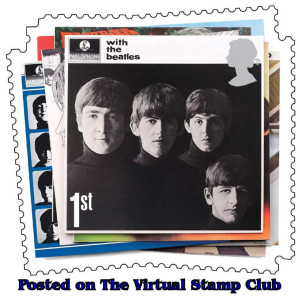 Some of the most popular stamp issues in recent years include:
Some of the most popular stamp issues in recent years include:
- Battle of Trafalgar (2005)
- The Beatles (2007)
- Olympic and Paralympic Gold Medal Winners (2012)
- Doctor Who (2013)
- Outside London, the most featured city in the Special Stamp programme is Edinburgh followed by the town of Battle, East Sussex
- Royal Mail has launched an online gallery of every Special Stamp issued since 1965. A short video presented by broadcaster and historian Dan Snow is also available. Both can be found at www.rmspecialstamps.com
- Royal Mail today announced that 2015 marks the 50th anniversary of the Special Stamps programme, which celebrates the UK and our national character.Criteria for the creation of Special Stamps to celebrate events and commemorate anniversaries relevant to UK heritage and life was devised by the then Postmaster General, Tony Benn, who worked with designer David Gentleman to modernise stamp design. The stamp of Sir Winston Churchill, issued in July of that year, was designed by Gentleman and was the first under Benn’s administration. It was the first British stamp to feature a contemporary individual and with its bold modernist approach with no words, it set the scene for the future. Including these, 2,663 Special Stamps have been issued.
Reflecting changes in society and culture
Over the past 50 years, Royal Mail stamps have mirrored the changes in society and culture at large. Stamps in the late 1960s celebrated the technological innovations of Britain, like the 1966 set which included the Jodrell Bank radio telescope, the hovercraft and the car industry. By 1982 stamps were commemorating the growing role of computers with Information Technology stamps depicting the then cutting-edge technology of lasers reading bar codes. 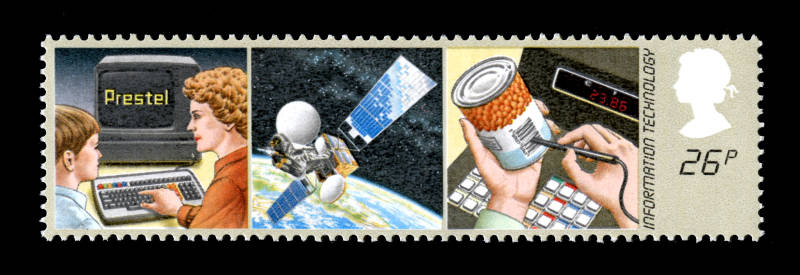 This stamp is an early example of computer-assisted design. It remains Britain’s widest-ever stamp. Popular culture has been charted by stamps. As the Sixties generation grew up, many of their influences, such as pop music, moved into the mainstream. In the 1988 stamps celebrating the bicentenary of Australian settlement, an image of John Lennon appears alongside Shakespeare to represent Britain’s cultural contribution. The Beatles moved centre stage with their own stamp issue in 2007. This featured their classic album sleeves and remains the most popular stamp issue of the last ten years, and was one of the first to feature identifiable living people.
This stamp is an early example of computer-assisted design. It remains Britain’s widest-ever stamp. Popular culture has been charted by stamps. As the Sixties generation grew up, many of their influences, such as pop music, moved into the mainstream. In the 1988 stamps celebrating the bicentenary of Australian settlement, an image of John Lennon appears alongside Shakespeare to represent Britain’s cultural contribution. The Beatles moved centre stage with their own stamp issue in 2007. This featured their classic album sleeves and remains the most popular stamp issue of the last ten years, and was one of the first to feature identifiable living people.
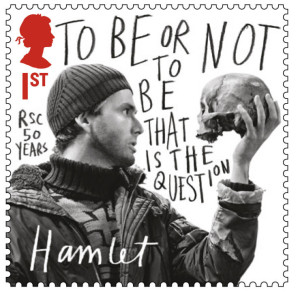 The commemoration of Shakespeare underlines how stamps have changed. In 1982 a set of stamps on the performing arts included a colourful painting of Hamlet. Thirty years later, a photo of actor David Tennant as Hamlet in contemporary dress and text in striking calligraphy reflected evolving interpretations of the Bard’s work.
The commemoration of Shakespeare underlines how stamps have changed. In 1982 a set of stamps on the performing arts included a colourful painting of Hamlet. Thirty years later, a photo of actor David Tennant as Hamlet in contemporary dress and text in striking calligraphy reflected evolving interpretations of the Bard’s work.
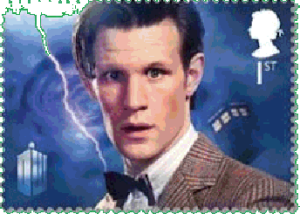 Explorations of our love of popular culture have continued with highly successful stamps celebrating Harry Potter, Doctor Who and children’s TV icons like Bagpuss.
Explorations of our love of popular culture have continued with highly successful stamps celebrating Harry Potter, Doctor Who and children’s TV icons like Bagpuss.
Stamp issues featuring sport have always generated interest with ‘England Win the Rugby World Cup’ (2003) and Gold Medal Winners at the Olympic Games and Paralympic Games among the most popular.
Most featured subjects
One of the consistently popular subjects featured on Special Stamps is the Royal Family, in particular national events such as Royal Weddings, the most recent being the marriage of Prince William to Catherine Middleton in 2011.
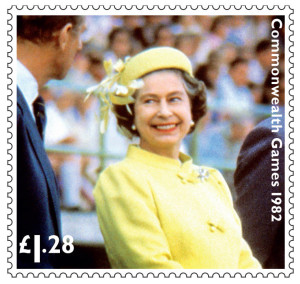 Over the past 50 years, The Queen is the person to feature most on Royal Mail Stamps. That doesn’t count Her Majesty’s silhouette in the corner of each Special Stamp. The next most popular individual to feature is The Duke of Edinburgh. He is followed by William Shakespeare – his face, as well as his work. The following have also appeared or had their contribution celebrated: Charles Darwin, HRH Prince Charles, HM The Queen Mother and Winston Churchill.
Over the past 50 years, The Queen is the person to feature most on Royal Mail Stamps. That doesn’t count Her Majesty’s silhouette in the corner of each Special Stamp. The next most popular individual to feature is The Duke of Edinburgh. He is followed by William Shakespeare – his face, as well as his work. The following have also appeared or had their contribution celebrated: Charles Darwin, HRH Prince Charles, HM The Queen Mother and Winston Churchill.
The UK’s towns and cities have influenced stamp designs over the past 50 years. Unsurprisingly, London is the city that features most followed by Edinburgh, Battle (East Sussex), Liverpool, York, Abbotsbury (Dorset) and Bath, Birmingham, Caernafon and Stratford-upon-Avon.
The most featured building or specific location is Buckingham Palace. Kew Gardens and St Paul’s Cathedral are next, followed by Abbotsbury Swannery (Dorset) and York Minster, Caernafon Castle and the Palace of Westminster.
Animals and transport have always proved popular subjects for stamps. Various species of bird have appeared most frequently followed by dogs, horses and cats. Reflecting the nation’s maritime heritage, ships and boats top the list of modes of transport followed by trains, aircraft, cars and buses.
As part of the programme to celebrate the 50th anniversary of the Special Stamp programme, Royal Mail has launched an online gallery of every Special Stamp issued since July 1965. Visitors to the site at www.rmspecialstamps.com can browse through the stamps by the decade and also view the stamps that were issued in the year that they were born.
A short video presented by broadcaster and historian Dan Snow explores how the Special Stamp programme has been shaped by the changing face of the UK and is also on www.rmspecialstamps.com.
Special Stamp Programme – Criteria
The criteria have remained virtually unchanged since introduced by Postmaster General, The Right Honourable Tony Benn. They are to:
-
-
- Commemorate important anniversaries
- Commemorate events of national importance, including major contemporary UK successes on the international stage
- Reflect the contribution of the UK to world affairs in the broadest range of activities, from the arts and humanities to science and technology
- Explore ‘the British way of life’, celebrating the diversity of cultures and interests within the UK
- Contribute to the cultural life of the UK through the patronage of art and design
-
Other key facts
Counties that have been featured on Special Stamps (with identifiable content)
-
-
- Greater London: 100 stamps
- Edinburgh: 12
- Gwynedd: 12
- East Sussex: 11
- Kent: 10
- Dorset: 9
- Yorkshire: 9
- County Antrim: 8
- Somerset: 8
- Surrey: 8
-
Themes that have been featured on Special Stamps
-
-
- Social History and Politics: 72 stamp issues
- Animals and Natural World: 62 stamp issues
- Christmas: 49 stamp issues
- Visual & Performing Arts: 45 stamp issues
- Royalty: 37 stamp issues
- Sport: 35 stamp issues
- Architecture & Built Environment: 34 stamp issues
- Science/Engineering/Space: 32 stamp issues
- Literature: 32 stamp issues
- Transport: 28 stamp issues
-
Current stamps and stamp products are available at 8000 Post Office branches, online at www.royalmail.com/stamps and from Royal Mail Tallents House (tel. 03457 641 641), 21 South Gyle Crescent, Edinburgh, EH12 9PB.




One thing I enjoy about the UK commemorate stamps is the prestige books that Royal Mail produces. I know some collectors object to the volume and cost, but I think they are a good way to teach the history and culture of the UK.